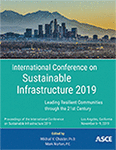International Conference on Sustainable Infrastructure 2019
Evaluating the Effectiveness of Best Management Practices in the Los Angeles River Watershed
Publication: International Conference on Sustainable Infrastructure 2019: Leading Resilient Communities through the 21st Century
ABSTRACT
Best management practices (BMPs) are now an essential component of urban infrastructure as impermeable surfaces have disrupted the natural hydrology in developing watersheds. BMPs can be used to offset the extreme changes to surface flow due to urbanization. In this work, a series of infiltration basins were added to a hydrologic model to evaluate their effect on the urban hydrology of the Los Angeles River watershed. The watershed was represented using EPA’s BASINS model that extracted the river network and existing land cover patterns, geomorphology, and other physiological features using remotely sensed observations. Hydrologic simulations were conducted using the Environmental Protection Agency’s (EPA) hydrologic simulation program—Fortran (HSPF). Calibration results demonstrate reasonable representation of annual streamflows and storm peak flows when compared to historical observations. After calibration, percent land cover was allocated to the infiltration basins (increasing from 0 to 6) in an attempt to lower streamflows to pre-urbanization levels. Results of the model indicate that BMPs do reduce streamflows within the channel; however, there is an effective threshold—flows exceeding the threshold are not reduced (in some cases they increase), and flows below the threshold are reduced. As we increase the number of BMPs, there is not an increase in effectiveness as originally hypothesized. We found that infiltration basins will not sufficiently reduce streamflows within the Los Angeles River watershed. In future work, we will explore the inclusion of other BMP types and placement in an effort to reduce hazardous flows in the face of an uncertain climate.
Get full access to this chapter
View all available purchase options and get full access to this chapter.
REFERENCES
Ackerman, D., Schiff, K. C., & Weisberg, S. B. (2005). Evaluating HSPF In An Arid, Urbanized Watershed. Journal of the American Water Resources Association, 41(2), 477-486.
Bicknell, B. et. al. (2000). Hydrological Simulation Program—Fortran (HSPF): User’s Manual for Release 12, US Environmental Protection Agency: Athens, GA.
Damodaram, C. et. al. (2010). Simulation of Combined Best Management Practices and Low Impact Development for Sustainable Stormwater Management1. JAWRA Journal of the American Water Resources Association, 46(5), 907-918.
He, C. (2003). Integration of geographic information systems and simulation model for watershed management. Environmental Modelling & Software, 18(8-9), 809-813.
Hettiarachchi, S., Wasko, C., and Sharma, A. (2018). Increase in flood risk resulting from climate change in a developed urban watershed – the role of storm temporal patterns, Hydrol. Earth Syst. Sci., 22(2041-2056), https://doi.org/10.5194/hess-22-2041-2018
Hortness, J. “Urban Best Management Practices.” USGS, 2008, www.usgs.gov/centers/glri/science/urban-best-management-practices?qt-science_center_objects=0#qt-science_center_objects.
Jang, S., Cho, M., Yoon, J., Yoon, Y., Kim, S., Kim, G., … Aksoy, H. (2007). Using SWMM as a tool for hydrologic impact assessment. Desalination, 212(1-3), 344-356.
Kounina, A. et. al. “Spatial Analysis of Toxic Emissions in LCA: A Sub-Continental Nested USEtox Model with Freshwater Archetypes.” Environment International, 69(67-89).
LACDPW. (2018).“Los Angeles River Watershed.” Department of Public Works, 25 Jan. 2018, https://dpw.lacounty.gov/wmd/watershed/la/
LADWP. (2013). “Sources of Supply.” Los Angeles Department of Water and Power, retrieved from: https://www.ladwp.com/ladwp/faces/ladwp
Lee, J. G., Nietch, C. T., and Panguluri, S. (2017).: Subcatchment characterization for evaluating green infrastructure using the Storm Water Management Model, Hydrol. Earth Syst. Sci. Discuss., https://doi.org/10.5194/hess-2017-166
Lopez, S. R., Hogue, T. S., & Stein, E. D. (2013). A framework for evaluating regional hydrologic sensitivity to climate change using archetypal watershed modeling. Hydrology and Earth System Sciences Discussions Hydrol. Earth Syst. Sci. Discuss., 9(12), 13729-13771.
US Environmental Protection Agency. (2018, March 06). Hydrological Simulation Program - FORTRAN (HSPF). Retrieved Sept. 10, 2014, Retrieved from https://www.epa.gov/ceam/hydrological-simulation-program-fortran-hspf
Sun, Y. et al. (2014). Hydrological simulation approaches for BMPs and LID practices in highly urbanized area and development of hydrological performance indicator system. Water Science and Engineering, 7(143-154).
Information & Authors
Information
Published In
International Conference on Sustainable Infrastructure 2019: Leading Resilient Communities through the 21st Century
Pages: 17 - 28
Editors: Mikhail V. Chester, Ph.D., Arizona State University, and Mark Norton, Santa Ana Watershed Project Authority
ISBN (Online): 978-0-7844-8265-0
Copyright
© 2019 American Society of Civil Engineers.
History
Published online: Nov 4, 2019
Authors
Metrics & Citations
Metrics
Citations
Download citation
If you have the appropriate software installed, you can download article citation data to the citation manager of your choice. Simply select your manager software from the list below and click Download.
